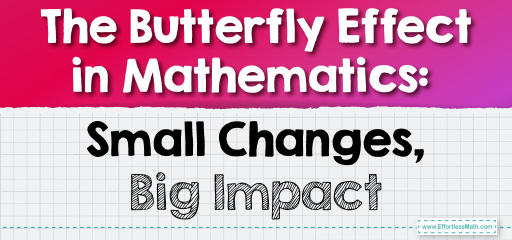The Butterfly Effect in Mathematics: Small Changes, Big Impact

Mathematics experts provide different ways of solving math problems. Learners and professionals may solve them by observing patterns or using different formulas. They may solve equations or adopt the trial-and-error method. One of the least-known strategies is the butterfly effect.
In chaos theory, the concept relies on the notion that making a minor change in the original condition can trigger a resounding outcome in the latter condition. It originated from observing a butterfly that flaps its small wings yet it can create a typhoon. Under this observation, mathematicians can believe that small changes lead to big results.

Why is it called a butterfly?
Edward Lorenz, a meteorologist in the 196os was observing the weather on his computer. Over time, he noted that the smallest changes in the weather chart sometimes meant the biggest changes in weather physically. He called the small changes butterfly changes. He called them so because he likened them to a tiny butterfly flapping its wings. He noted that the changes he saw on his computer had no comparison with happenings in the skies.
It would be at one time sunny and suddenly storms would start. He called these little effects the butterfly effect. It was from that experience that the butterfly math concept was created. Mathematicians came to believe that dependencies on initial conditions are significantly related to getting results that could never have been thought about.
The butterfly effect can be used in many areas of life. In college, it can be used to help students understand the impact of spending extra time studying and the final results after exams. Cause and effect essays explain how things happening in an event impact things happening in another event. For instance, excess food is one thing that can significantly cause changes in other things such as weight gain and poor performance. A student can understand how cause and effect works by reading examples of cause and effect essays online. Reading writing examples assist students in learning research strategies and how to organize their work.
Butterfly effect example
Nonlinear equations
In math, linear equations rely on a single or 2 variables and their power is always less than one. Nonlinear equations rely on 2 or more variables. They usually have a curve formed under the x and y variables. The slightest change in variables in nonlinear equations can significantly impact the solutions or equation behavior. It might simplify the structure or make it complex. The mathematician might discover concepts they might have never discovered by simply altering equations. Initial conditions matter in nonlinear equations. A slight change in them can cause an exponential change in their outcomes.
Weather forecasting
Math language is significant when interpreting weather patterns on a computer and publishing the prediction in numerical form. The data assimilation concept is applied to forecast the happenings in the physical weather patterns. Due to this, weather experts use numerical models as math representations to explain the dynamics in the sky. The butterfly effect explains the significance of paying attention to the tiniest changes in initial conditions. The tiniest of it can have devastating effects on weather prediction over time.
Financial markets
Financial markets significantly rely on the butterfly effect. The market moves billions of money daily. On the board, a trader might be observing and ignoring small changes. When multiplied with numbers, the slightest change could mean the biggest loss or gain. The effect works perfectly in other areas such as population growth and navigation. It is applied in space exploration and biological systems.
Taking care of chaos by applying the butterfly effect
Chaos in life could have devastating negative effects but they can also bring lasting positive outcomes. People go through chaos in terms of disasters, pandemics, climate change, and effects on the supply chain. When Lorenz first explained the butterfly effect, many people including scientists kept asking if the butterfly effect real.
Sometime later, his idea began to be used in chaos theory. The theory to date is used to forecast how unpredictable situations or systems might behave if there were slight changes in the initial condition. Through the years, scientists have used the butterfly effect to understand changes in climate due to slight changes in things such as C02.
After realizing the significant changes the small things cause, they believed Lorenz’s definition was real. They realized the effect is applied daily in life and many times people don’t even realize it. When they define the butterfly effect, scientists argue that chaos can be beneficial to humans.
They argue that the important point is to understand how to control chaos and use them to your advantage. In math, the concept uses strategies of controlling complex formulas or problems to get insights. Through these insights, people can develop solutions that last. Based on science, solutions come by destabilizing the chaos. The differences might be minute or delicate but they create an opportunity to discover more things that might have never been possible.

Manipulation is not the butterfly effect idea
In his book titled Team of Teams, General Stanly explained that the butterfly effect does not rely on manipulation. He explains that people misunderstand the effect and base it on the impact of leveraging. To leverage, they manipulate things hoping they will give a butterfly effect outcome. Stanley notes that this is a misuse of the phrase and Lorenz’s idea. Based on Lorenz, it is impossible to predict whether the small changes will cause a positive or negative outcome. It is not possible to predict how massive the change will be. It can be a small or big outcome.
Geologists study the happenings deep into the earth and give numerical explanations. Based on studies, the slightest change in tectonic plates can cause huge volcanic or seismic activity. The outcomes at other times are minute and never felt on the surface of the earth. It is impossible to manipulate them but geologists can only give numerical tables or graphs to explain what might happen and prepare the people.
Phrases used to explain the butterfly effect
Experts and ordinary people have used different butterfly phrases to explain the effect. Here are some of them.
- “Never undervalue the power of a butterfly’s flutter.” “It can cause a global cyclone.” (FSM Statistics)
- “Butterflies recognize the beauty in transformation.” (Anonymous)
- In the Amazon rainforest, a butterfly flicks its wings.” “A hurricane rips through half of Europe.” (Neil Gaiman)
- “Modify one item, alter everything.” (Verändere Zukunft)
Conclusion
The butterfly effect was first explained by Edward Lorenz as he observed the significant effect small changes had on weather patterns. The phrase was adopted in math and used to explain chaos theory. Today, the butterfly effect concept is applied in many areas of science and art. It is used to explain how to take advantage of chaos to create lasting solutions.
Related to This Article
More math articles
- Word Problems Involving Money
- Algebra Puzzle – Challenge 48
- 5th Grade OSTP Math Worksheets: FREE & Printable
- Top 10 Tips to Overcome ASTB Math Anxiety
- What Skills Do I Need for the TASC Math Test?
- What is the Best Scientific Calculator for College Students?
- How to Identify the Value of a Digit on Numbers Up to a Billion
- How to Categorize Rational Numbers
- Overview of the ACT Mathematics Test
- Top 5 Free Websites for Pre-Algebra Preparation





























What people say about "The Butterfly Effect in Mathematics: Small Changes, Big Impact - Effortless Math: We Help Students Learn to LOVE Mathematics"?
No one replied yet.